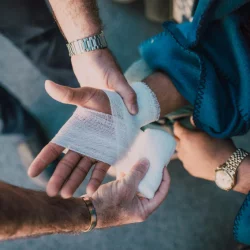Claiming Compensation When You Contributed to Your Accident
You probably know you can claim compensation if you’re in an accident caused by someone else, but what happens if you’re also to blame?
Perhaps another driver rear-ended your car, but you were driving too slowly or were distracted at a stop light and didn’t accelerate when the driver expected you to.
Maybe you slipped at work on a wet floor because cleaning contractors failed to set down signs, but you were looking at your cell phone and not where you were going.
The other party might argue that the accident could have been avoided — or might not have been as bad — if you were paying attention or taking more care, and they might have a case.
But how does that affect whether you can claim compensation?
What Are Negligence Laws?
Negligence laws vary by state, so when an accident is partly your fault, you may still be entitled to compensation. In some states, though, you won’t be able to claim at all.
Personal injury negligence laws are split into three categories:
- Contributory negligence
- Pure comparative negligence
- Modified comparative negligence.
Contributory Negligence
Contributory negligence is the strictest type of negligence law in effect in the U.S. This law prevents a plaintiff (the person seeking compensation from another party) from claiming if they are at fault.
It doesn’t matter if another person or party was majorly responsible or if you’ve sustained severe injuries — if you contributed in any way, you cannot recover damages.
For example, let’s say you’re crossing a road and fail to check for traffic before darting across, resulting in you getting run over and breaking several bones.
If the accident happens in a state with contributory negligence laws, you wouldn’t be able to claim compensation.
Why? Because crossing the road without care — such as darting across or failing to wait for a stop light — constitutes recklessness. The driver who ran you over might be intoxicated or distracted, but this won’t change the outcome, and you’ll still be barred from a claim.
Contributory negligence has its fair share of critics — attorneys have slammed this doctrine as “archaic” since the 1950s. Yet, decades later, it continues to be implemented in Alabama, Maryland, North Carolina, and Virginia.
Pure Comparative Negligence
If contributory negligence laws are the most restrictive, pure comparative negligence laws are the other side of the coin.
In states implementing these laws, a plaintiff can file a personal injury claim regardless of their level of liability (providing they are not 100% responsible, in which case they cannot claim from another party).
Let’s illustrate this with another example. If you’re at a stop light and the vehicle behind you rear-ends your car because you were distracted when the lights turned green, you might be majorly responsible for your accident.
The other driver will still be partly liable because they failed to see you weren’t accelerating, but you are ultimately at fault because you were driving while distracted and should have hit the gas when the lights signaled you to.
In this case, you might be 70% responsible for the accident. However, in states with pure comparative negligence laws, you can still claim compensation for any injuries you’ve sustained, any wages you’ve lost because you’ve been unable to work, and pain and suffering.
Your compensation will be reduced by your percentage of fault, so if you are 70% liable, you can recover the remaining 30% from the other party.
The twelve states that adopt pure comparative negligence laws are:
- Alaska
- Arizona
- California
- Florida
- Kentucky
- Louisiana
- Mississippi
- Missouri
- New Mexico
- New York
- Rhode Island
- Washington
Modified Comparative Negligence
In the midpoint between contributory and pure comparative negligence laws sits modified comparative.
Like pure comparative, modified comparative laws allow plaintiffs to claim compensation if they are partly at fault for the accident — but only if their liability falls below a set threshold.
This threshold varies by state but is always either 50% or 51%.
Most states (33) in the U.S. adopt this law, with 23 states having a cap of 51% and 10 setting a cap of 50%.
To illustrate this law, we’ll look at our previous two examples.
If you are in the same rear-end car accident explained above where you are 70% at fault, you will be able to claim compensation if you’re in a pure comparative state such as Florida. However, if the accident happens in Arkansas, which adopts the 50% rule, you will not be able to claim, as you can only do so if you are 49% or less responsible.
In the example of contributory negligence, where a pedestrian injured while recklessly crossing the road would not be able to claim, the outcome would be different in a modified comparative state.
If this accident happened in Texas, where the cap for claiming compensation is 51%, and you are just 20% responsible, a personal injury lawyer in McAllen would be able to help you recover that other 80% in compensation.
South Dakota and Slight-Gross Comparative Negligence
There’s one exception to the negligence laws outlined above, and that’s in South Dakota. Here, a plaintiff can recover compensation if their fault was “slight” and the other party’s contribution to the accident was “gross.”
If the plaintiff’s fault is slight — rather than another party being 100% liable — the compensation they’re awarded is reduced accordingly, but if the fault is more than slight, or there is no discernible difference between the fault of the plaintiff and the defendant, they cannot claim compensation.
Because negligence laws vary by jurisdiction, it’s difficult to offer blanket guidance for the situation you might find yourself in. If you’re in an accident and it was partly your fault, it’s easy to assume you won’t be entitled to compensation, but that might not be the case. You should always seek advice from an attorney — many offer free consultations — as you may be entitled to a significant sum to help you move forward after your injuries.
More to Read:
Previous Posts:




